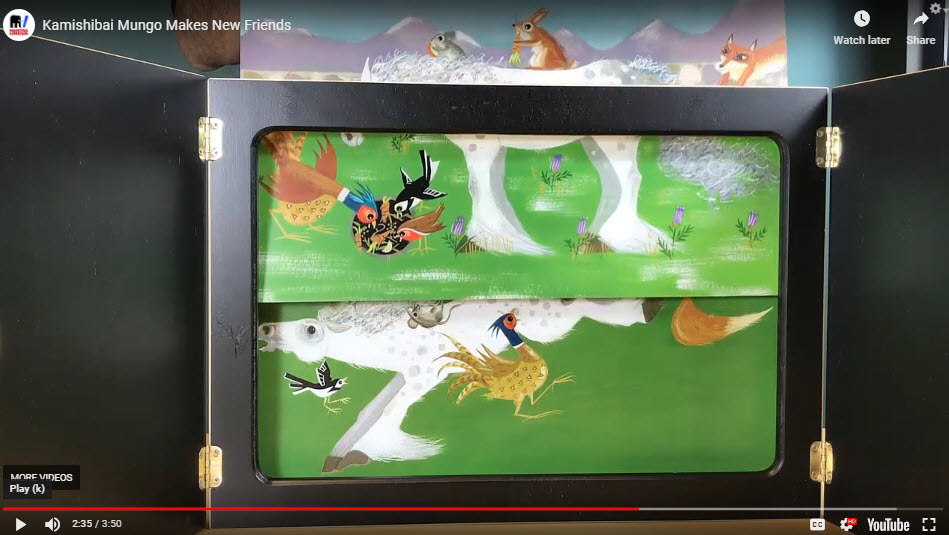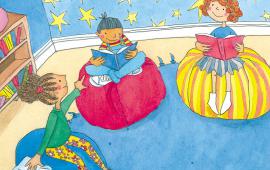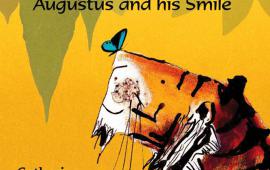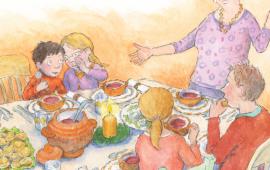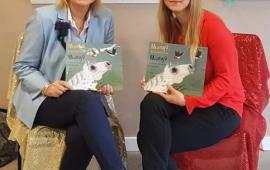Once upon a time, in a not-so-faraway land…
Stories – they’re the way we make sense of our world. And while we all love to sit and listen to a story, adding images can help to really bring it to life.
Kamishibai, literally “paper play”, is a Japanese storytelling technique which dates from at least the 1930s, although its origins may be much older. Written Japanese uses kanji characters, or pictograms, to convey meaning and language; and images have always been especially important to get a message across.
Kamishibai uses theatrical techniques and picture storyboards to tell a story – and is suitable for use with any language. It’s an ideal way to develop listening and speaking skills in the first instance; the narrator can tell the tale, the teacher can then ask learners to repeat, or describe the story from the beginning. The technique is suitable for use with any level of language learning too – novice learners could concentrate on nouns, adjectives and verbs, progressing to different tenses, while intermediate learners could explore possibilities via the modal verbs of should, would, could, and might. And advanced learners could use it as a basis for writing their own stories or short plays.
The Kamishibai approach could be used for further language development by encouraging the learner to write a narrative based on the storyboards. Different characters speak in different ways; everyone has their own distinctive “voice”, and this is another aspect to explore. It could be used to investigate how the registers used vary in written and spoken language.
Rochdale Teaching and Learning Advisor Erica Field suggests an approach to writing which can be used very effectively with Kamishibai. Initially, students become familiar with the genre or text type, before progressing to the next stage: capturing ideas and oral rehearsal. Following a teacher demonstration, it’s time to move on to the “getting it down on paper” stage. This might include teacher scribing, then supported and guided writing, and finally, independent writing.
From a practical perspective, the instructor might first introduce new vocabulary to the learners, and then tell the story, helping students to identify the new terms. Following the first reading, students might listen a second time, pronouncing the new vocabulary as it occurs, before progressing to capturing their ideas, and then rehearsing their own oral presentation of the tale. The teacher may then demonstrate some example model sentences; learners could tell the teacher the story so that it can be written down; the next two stages are supported writing and guided writing, with prompts as appropriate.
In the final stage, learners are able to write the story, or a related narrative, independently – a crucial part of the SATs process. At this point, reading aloud to oneself can be particularly effective. So if you come across a language learner peering at pictures and talking to themselves, they may well be using Kamishibai techniques.
References
Enjelvin, G. D. (2018), Kamishibai: how the magical art of Japanese storytelling is being revived and promoting bilingualism, June 28, 2018 http://theconversation.com/kamishibai-how-the-magical-art-of-japanese-storytelling-is-being-revived-and-promoting-bilingualism-97041 [accessed 25 February 2019]
The Linking Network (2019), https://thelinkingnetwork.org.uk [accessed 25 February 2019]
Kamishibai, literally “paper play”, is a Japanese storytelling technique which dates from at least the 1930s, although its origins may be much older. Written Japanese uses kanji characters, or pictograms, to convey meaning and language; and images have always been especially important to get a message across.
Kamishibai uses theatrical techniques and picture storyboards to tell a story – and is suitable for use with any language. It’s an ideal way to develop listening and speaking skills in the first instance; the narrator can tell the tale, the teacher can then ask learners to repeat, or describe the story from the beginning. The technique is suitable for use with any level of language learning too – novice learners could concentrate on nouns, adjectives and verbs, progressing to different tenses, while intermediate learners could explore possibilities via the modal verbs of should, would, could, and might. And advanced learners could use it as a basis for writing their own stories or short plays.
The Kamishibai approach could be used for further language development by encouraging the learner to write a narrative based on the storyboards. Different characters speak in different ways; everyone has their own distinctive “voice”, and this is another aspect to explore. It could be used to investigate how the registers used vary in written and spoken language.
Rochdale Teaching and Learning Advisor Erica Field suggests an approach to writing which can be used very effectively with Kamishibai. Initially, students become familiar with the genre or text type, before progressing to the next stage: capturing ideas and oral rehearsal. Following a teacher demonstration, it’s time to move on to the “getting it down on paper” stage. This might include teacher scribing, then supported and guided writing, and finally, independent writing.
From a practical perspective, the instructor might first introduce new vocabulary to the learners, and then tell the story, helping students to identify the new terms. Following the first reading, students might listen a second time, pronouncing the new vocabulary as it occurs, before progressing to capturing their ideas, and then rehearsing their own oral presentation of the tale. The teacher may then demonstrate some example model sentences; learners could tell the teacher the story so that it can be written down; the next two stages are supported writing and guided writing, with prompts as appropriate.
In the final stage, learners are able to write the story, or a related narrative, independently – a crucial part of the SATs process. At this point, reading aloud to oneself can be particularly effective. So if you come across a language learner peering at pictures and talking to themselves, they may well be using Kamishibai techniques.
References
Enjelvin, G. D. (2018), Kamishibai: how the magical art of Japanese storytelling is being revived and promoting bilingualism, June 28, 2018 http://theconversation.com/kamishibai-how-the-magical-art-of-japanese-storytelling-is-being-revived-and-promoting-bilingualism-97041 [accessed 25 February 2019]
The Linking Network (2019), https://thelinkingnetwork.org.uk [accessed 25 February 2019]
Related Posts
-
Banking on the late August bank holiday - just how did bank holidays begin, anyway?
-
Translating or translanguaging? Helping multilingual pre-schoolers communicate - research from the Victoria University of Wellington
-
Ten Tips to Help Your Child Adjust to Life in a New Country
-
Early to bed, early to rise, makes [us all] healthy, wealthy and wise.
-
Silence in the library? How wordless books are helping to heal Lampedusa
-
What do you mean, it's mensis Sextilis? What have the Romans got to do with August?
-
How does Christmas sound to you? The noises, tastes and textures of the festive season
-
How to help your bilingual child speak your first language
-
From A to E – why the first five letters of the alphabet are so important when it comes to vitamins
-
Writers, Illustrators and Critics of the Future - Mungo Makes New Friends at Dundee Polish School

